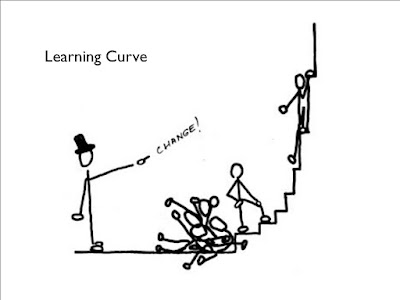I am always learning a lot about Fibromyalgia even though I thought I knew a lot about it.
I was diagnosed with Fibro a long time ago. When I was first diagnosed I was under the misunderstanding that Fibro or FMS was the same as CFS - Chronic Fatigue Syndrome. I learnt very early on that it wasn't true.
I was also one of those people who judged people with Fibromyalgia. This judgement came from lack of understanding about the condition. So now I have been on both sides of the coin - both the judger and the judged.
I also believed that Fibromyalgia had a stigma about it and that it was a diagnosis given when doctors could not find anything else wrong. I now know that it is a true condition.
I believe that it is difficult to educate the general population about Fibromyalgia. People just don't really want to know and they are overwhelmed with so much information about so many different things.
I believe that understanding is rare but Fibromyalgia is not.
"Fibromyalgia is one of the most common types of chronic pain disorders. It is estimated that more than 5 million people in the United States have fibromyalgia." FIBROCENTER
I believe that with any chronic condition you have to constantly educate yourself about your disease.
This year I have learnt new things about Fibromyalgia including - Fibromyalgia Patients Have Decreased Brain Connectivity in some regions of the brain, that CBD oil and low dose naltrexone (LDN) are both being used in treating Fibromyalgia.
Learning to live with a fibromyalgia diagnosis is often overwhelming at first, and the learning curve can feel steep. You're not just managing pain - you're adjusting to a new way of understanding your body, energy, emotions, and lifestyle. Here’s a breakdown of what the learning curve typically looks like, and how to navigate it with more clarity and confidence.
The Learning Curve of Fibromyalgia: A Realistic Overview
Stage 1: Understanding the Diagnosis
“What is happening to me?”
-
Common Feelings: Relief (finally a name for the symptoms), disbelief, confusion, grief
-
Key Challenges: Accepting it’s chronic, navigating misinformation, dealing with stigma
-
First Steps:
-
Learn about central sensitization (your nervous system is overreactive to pain/stimuli)
-
Understand that it’s real, even if invisible
-
Find a doctor who takes it seriously
-
Stage 2: Tracking and Identifying Triggers
“What makes it better or worse?”
-
Common Symptoms: Widespread pain, fatigue, brain fog, sleep disturbance
-
Key Tools:
-
Keep a symptom journal (sleep, activity, food, pain levels)
-
Identify flare triggers: stress, overexertion, weather changes, poor sleep, certain foods
-
-
Start slow: You don’t have to figure it all out at once
Stage 3: Lifestyle Adjustment and Self-Management
“How do I live with this?”
-
Learn pacing: Avoid the “push-crash” cycle of overdoing it on good days and crashing after
-
Start low-impact movement: Gentle yoga, walking, tai chi
-
Focus on sleep hygiene: Crucial to managing symptoms
-
Experiment with diet: Some find symptom relief by reducing gluten, sugar, or processed foods
-
Mind-body techniques: Meditation, mindfulness, CBT, or ACT can help manage the emotional toll
Stage 4: Treatments and Trial-and-Error
“What actually helps me?”
-
Medications: Low-dose antidepressants (e.g. amitriptyline), gabapentin, pregabalin, or duloxetine may be helpful—but effects vary
-
Supplements: Magnesium, CoQ10, vitamin D—talk to your doctor
-
Topical pain relief: Tiger Balm, lidocaine patches, Voltaren gel
-
Professional support: Pain specialists, physiotherapists, occupational therapists, or therapists who understand chronic illness
Stage 5: Advocacy and Mental Resilience
“How do I build a life with this?”
-
Learn to say no without guilt and prioritize energy
-
Find a support system: Online communities, local support groups
-
Manage flare-ups with compassion, not blame
-
Deal with the invisible illness issue: Some people won’t understand—you don’t need their validation
-
Explore purpose and joy beyond productivity
It’s Not Linear
-
You’ll move back and forth between stages.
-
Flare-ups can knock you down even when you think you have it handled.
-
Self-kindness is the most important skill you’ll ever learn in this process.
- Fibromyalgia symptoms
- Fibromyalgia what is it?
- What is a spoonie?
- Natural Treatments for Fibromyalgia
- Medications used in Fibro
- 6 Strange Signs of Fibromyalgia
- Top Tips for Fibromyalgia
- Fibro and diet
NEW BELIEF: No 1. You can teach an old dog new tricks if they are willing to learn.


i am also looking forward to any answers to this puzzle
ReplyDeletehi Georgia, I too believe that fibromyalgia is like a puzzle and we haven't yet found all the pieces. Hopefully with continued research this will happen.
DeleteThanks for linking my portfolio blog to your 'All Things Good' blog. My daughter has been suffering from a bad case of Fibromyalgia for the last 10 years as well and I understand what you are going through. Wish there was an answer too.
ReplyDeleteThanks so much Ona and sorry to hear about your daughter. I would not wish this disease on anyone and it is hard to see our children in pain.
Delete